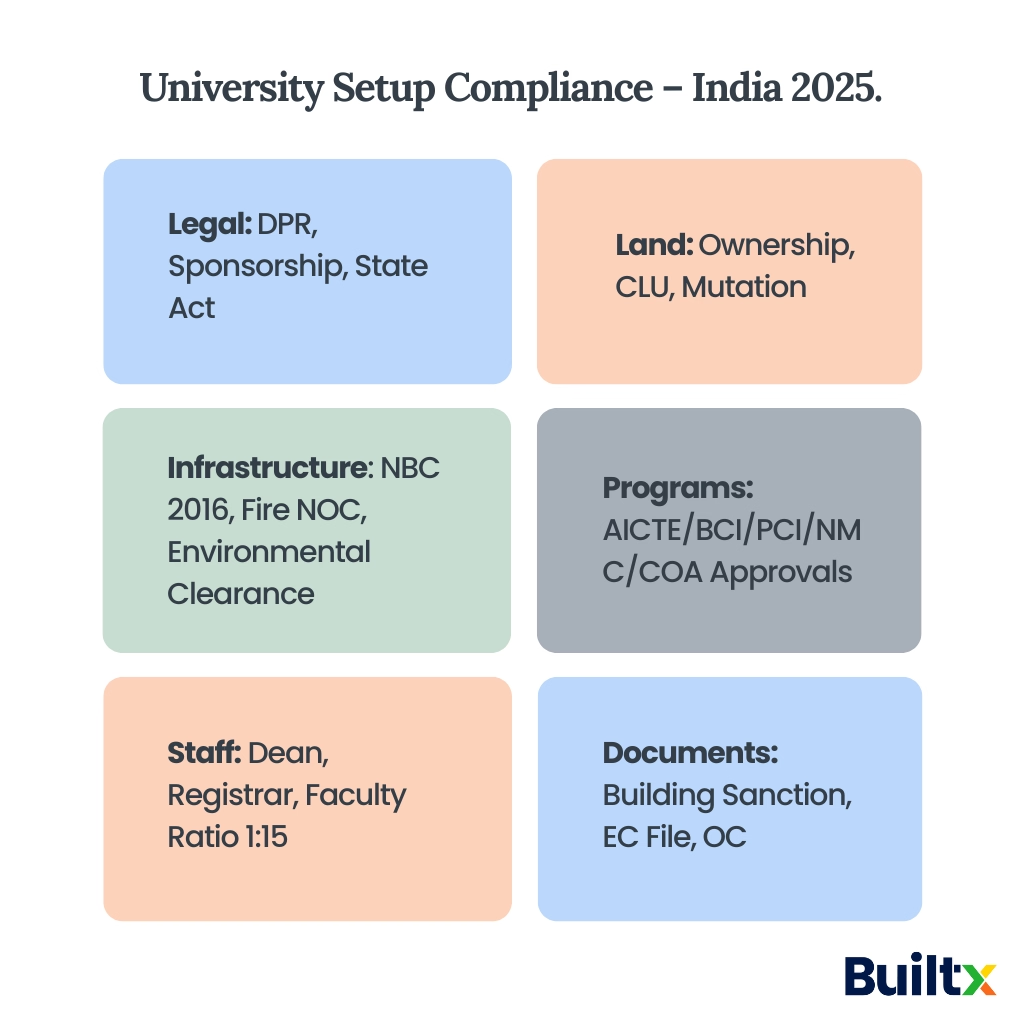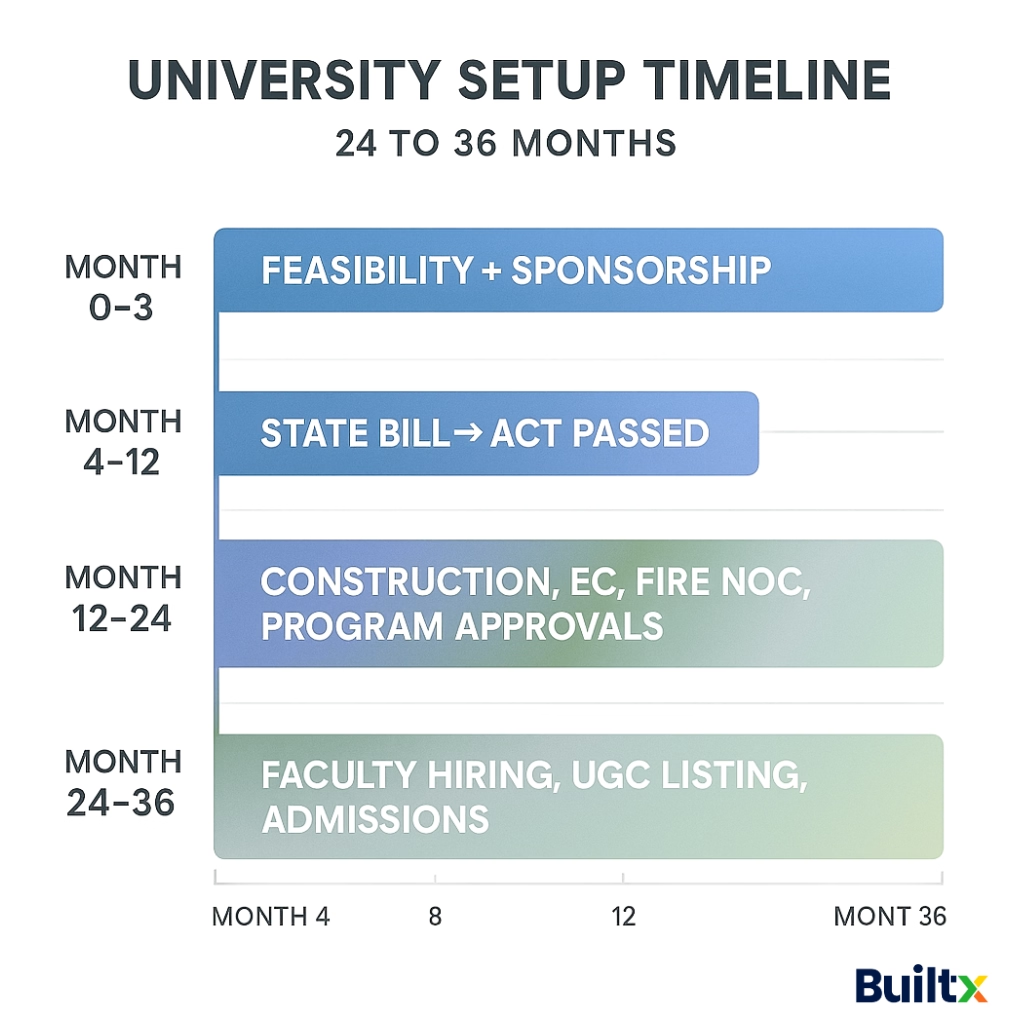How to Start a University in India (2025)

Table of Content
Key Takeaways
- Legal Route: A private university can only be established through a State Act, followed by UGC compliance and recognition.
- Bihar-Specific Norms: Requires 10 acres (rural) or 5 acres (urban) and a minimum ₹1 crore endowment.
- Regulatory Stack: Compliance needed from UGC, AICTE, BCI, PCI, NMC, COA, and others depending on programs offered.
- Infrastructure Norms: Must follow NBC 2016, EIA 2006, Fire NOC, and RPwD Act for universal accessibility.
- Realistic Timeline: Expect 24–36 months from DPR to first intake if execution is tightly managed.
- Challenges: Bureaucracy, NOC delays, and faculty hiring—de-risk them early with expert partnerships.
India is entering a new era in higher education. The National Education Policy (NEP) 2020 targets a 50% Gross Enrolment Ratio (GER) in higher education by 2035. This opens the door for private institutions to contribute significantly to capacity expansion.
If you’re planning to establish a university in India – especially in Bihar, UP, or Jharkhand – this guide explains the step-by-step legal, regulatory, infrastructural, and financial requirements based on verified data and official citations.
BuiltX has supported multiple educational infrastructure projects, so this guide reflects both compliance knowledge and ground-level challenges.
.avif)
Explore the complete university accreditation roadmap
Governing Authorities
- State Legislature: Must pass an Act to legally create the university
- UGC (University Grants Commission): Approves and lists private universities
- MoE (Ministry of Education): Policy driver (NEP 2020)
- Program Regulators: AICTE, PCI, BCI, COA, INC, NMC depending on your courses
NEP 2020 Influence
- Encourages multidisciplinary institutions
- Pushes for regulatory consolidation under HECI (yet to be fully implemented)
- Emphasizes accreditation: NAAC/NBA is becoming mandatory
In 2025, the legal bedrock to start a private university is still a State Act + UGC compliance.
UGC Guidelines (2025)
- UGC (Establishment and Maintenance of Standards in Private Universities) Regulations, 2003 still form the core legal reference
- New UGC notices allow off-campus centres within the same state, with permission
Legal Steps to Start a Private University
- Feasibility Study + Detailed Project Report (DPR)
- Create Sponsoring Body (Trust, Society, or Section 8 Company)
- Apply to State Higher Education Department
- State Government reviews & Cabinet approval
- Private University Bill is passed in State Assembly
- Gazette Notification = Legal Existence
- Apply to UGC for inspection & inclusion in official list
Licensing & NOCs Required
- Land Title & Mutation
- Change of Land Use (CLU) if needed
- Building Plan Approval from ULB/Development Authority
- Environmental Clearance (EIA Notification 2006, if built-up > 20,000 m²)
- Fire NOC under NBC 2016 Part 4
- Consent to Establish/Operate from State Pollution Control Board
- Occupancy Certificate post-completion

Top Construction Company for your purpose driven infrastructure
Land Requirements
There is no single UGC-mandated land minimum; States prescribe it.
- Bihar (Private Universities Act, 2013): 10 acres (outside municipal limits) or 5 acres (within municipal limits). (PRS India)
- Haryana (Act, 2006): 20 acres outside municipal limits or 10 acres within. (highereduhry.ac.in)
- Rajasthan (Act, 2005): 30 acres minimum + 10,000 m² built space for initial operations. (Indian Kanoon)
Design codes: Follow National Building Code (NBC 2016) (planning, structural, fire & life safety), and Model Building Bye-Laws 2016 for plan approvals. (bis.gov.in, Ministry of Housing and Urban Affairs)
Accessibility: RPwD Act 2016 mandates compliance with accessibility norms (ramps, lifts, tactile/visual signage, etc.). Use Harmonised Guidelines & Standards for Universal Accessibility (MoHUA, 2021) as design reference. (India Code, depwd.gov.in)
Zoning & Permissions
- Must comply with State Urban Development Rules
- CLU from revenue or municipal authorities is mandatory
Construction & Safety Norms
- National Building Code (NBC 2016) compliance
- Model Building Bye-Laws 2016
- RPwD Act 2016 + Harmonised Guidelines for Accessibility
Include these sustainable architecture practices in your project
Endowment / Corpus Requirements
Permanent endowment fund requirements vary by state (examples):
- Bihar: ₹1 crore endowment fund. (Indian Kanoon)
- Uttar Pradesh: ₹5 crore permanent endowment. (India Code)
- Haryana: typically ₹5 crore (amended), earlier ₹3 crore. (sushantuniversity.edu.in, ncuindia.edu)
- Gujarat: amount is as specified in the Letter of Intent (not a fixed number in the Act). (Indian Kanoon)
- Maharashtra (Act VIII of 2024): amount as notified by Government order. (PRS India)
Reality check: Apart from the statutory endowment, States often expect project investment commitments in DPR/LoI (land, core buildings, labs, hostels). Budget realistically for capex + 24-36 months runway.
Institutional Structure
- Board of Governors, Vice-Chancellor, Registrar, Finance Officer
- Academic Council, Finance Committee, Board of Studies as per First Statutes
Sustainability Planning
- Plan for operational runway of 2–3 years
- Ensure revenue from tuition, grants, partnerships
Program & Faculty Norms
- AICTE: Approval Process Handbook (2024–27)
- BCI, PCI, INC, NMC, COA: Individual norms per program
- Minimum faculty-student ratio: As per UGC & regulator guidelines
Accreditation
- NAAC (institution-level)
- NBA (program-level)
- Needed for future eligibility under public funding and autonomy schemes
Learn how top-ranking campuses design with NAAC, NBA, and NIRF in mind

- Bureaucratic cycles: Build a regulatory calendar; pre-meet authorities; file complete checklists (esp. EC/NOCs).
- Infrastructure phasing: Phase core-academic first; hostels/utilities in parallel; design to NBC 2016 (Part-4) and Harmonised Accessibility Guidelines from day one. (bis.gov.in, depwd.gov.in)
- Faculty pipelines: Offer joint appointments, start early with school heads, and align program filings with APH staffing norms. (aicte-india.org)
India’s educational landscape is expanding, but compliance is non-negotiable. Starting a private university requires
The State-Act right → UGC compliance airtight → program approvals sequenced → EC/NBC/RPwD done early.
No matter you are based on Bihar or Delhi, BuiltX can help you to build your dream university campus. At BuiltX, we've helped non-profits, educational trusts, and CSR initiatives across India successfully navigate regulatory complexities, build sustainably, and open doors without costly delays or retrofits. Our proven turnkey approach ensures your campus is ready from Day Zero.
Q1. Can I start a university with just UGC approval?
A1: No. You need a State Act first. UGC recognition comes after.
Q2. Does Bihar allow private universities?
A2: Yes. Under the Bihar Private Universities Act, 2013 with 2021 amendments.
Q3. What is the minimum land needed in Bihar?
A3: 10 acres outside municipal limits or 5 acres within.
Q4. Is Environmental Clearance mandatory?
A4: Yes, if built-up area exceeds 20,000 m² or if you're in a sensitive zone.
Q5. Can a private university offer online courses?
A5: Only with ODL/Online approval from UGC and within territorial jurisdiction.
Sources: UGC Regulations (2003), NEP 2020, Bihar Private Universities Act 2013, AICTE APH 2024–27, NBC 2016, EIA 2006, RPwD Act 2016.

